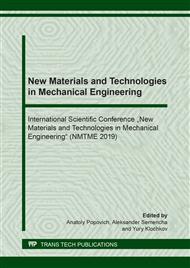[1]
Blinov, L. N. Glass chemistry: Problems, perspectives, and application (A review)., Glass Physics and Chemistry 42.5 (2016): 429-439.
DOI: 10.1134/s1087659616050047
Google Scholar
[2]
Dianov, Evgeny M. Bismuth-doped optical fibers: a challenging active medium for near-IR lasers and optical amplifiers., Light: Science & Applications 1.5 (2012): e12.
DOI: 10.1038/lsa.2012.12
Google Scholar
[3]
Bufetov, I. A., and E. M. Dianov. Bi-doped fiber lasers., Laser Physics Letters 6.7 (2009): 487.
DOI: 10.1002/lapl.200910025
Google Scholar
[4]
Khistiaeva, Viktoria V., et al. Heteroleptic β-diketonate Ln (iii) complexes decorated with pyridyl substituted pyridazine ligands: synthesis, structure and luminescence properties., Inorganic Chemistry Frontiers 5.12 (2018): 3015-3027.
DOI: 10.1039/c8qi00712h
Google Scholar
[5]
Xu, Beibei, et al. Multifunctional tunable ultra-broadband visible and near-infrared luminescence from bismuth-doped germanate glasses., Journal of applied physics 113.8 (2013): 083503.
DOI: 10.1063/1.4791698
Google Scholar
[6]
Yu, Pingsheng, et al. Broadband infrared luminescence in Bi-doped silicate glass., Journal of Non-Crystalline Solids 464 (2017): 34-38.
DOI: 10.1016/j.jnoncrysol.2017.03.017
Google Scholar
[7]
Larin, M. V., et al. The use of single-mode fiber laser for welding of stainless steel thin thickness., Journal of Physics: Conference Series. Vol. 1109. No. 1. IOP Publishing, (2018).
DOI: 10.1088/1742-6596/1109/1/012036
Google Scholar
[8]
Popov, S. M., et al. Brillouin lasing in single-mode tapered optical fiber with inscribed Fiber Bragg Grating Array., Results in Physics 9 (2018): 625-627.
DOI: 10.1016/j.rinp.2018.03.023
Google Scholar
[9]
Lipovskii, A. A., et al. Mid-range structure of niobium–sodium–phosphate electro-optic glasses., The Journal of Physical Chemistry B 117.5 (2013): 1444-1450.
DOI: 10.1021/jp3081244
Google Scholar
[10]
Donato, M. G., et al. Raman optical amplification properties of sodium–niobium–phosphate glasses., Applied Physics Letters 97.23 (2010): 231111.
DOI: 10.1063/1.3525162
Google Scholar
[11]
Ivanenko, Vladimir, et al. Principal studies on phosphate glasses for fertilizers., Landbauforschung Volkenrode 57.4 (2007): 323.
Google Scholar
[12]
De Jong, B. H. W. S., Charles M. Schramm, and Victor E. Parziale. Polymerization of silicate and aluminate tetrahedra in glasses, melts, and aqueous solutions—IV. Aluminum coordination in glasses and aqueous solutions and comments on the aluminum avoidance principle., Geochimica et Cosmochimica Acta 47.7 (1983): 1223-1236.
DOI: 10.1016/0016-7037(83)90064-9
Google Scholar
[13]
Povolotskiy, A. V., et al. Kinetics of laser induced color centers writing/erasing in alkali niobo-phosphate glasses., 2018 International Conference Laser Optics (ICLO). IEEE, (2018).
DOI: 10.1109/lo.2018.8435623
Google Scholar
[14]
Dubov, Mykhaylo, et al. Waveguide fabrication in lithium-niobo-phosphate glasses by high repetition rate femtosecond laser: route to non-equilibrium material's states., Optical Materials Express 4.6 (2014): 1197-1206.
DOI: 10.1364/ome.4.001197
Google Scholar
[15]
Vasileva, A. A., et al. Structural features of silver-doped phosphate glasses in zone of femtosecond laser-induced modification., Journal of Solid State Chemistry 230 (2015): 56-60.
DOI: 10.1016/j.jssc.2015.06.025
Google Scholar


